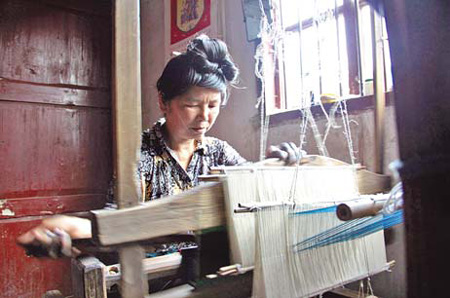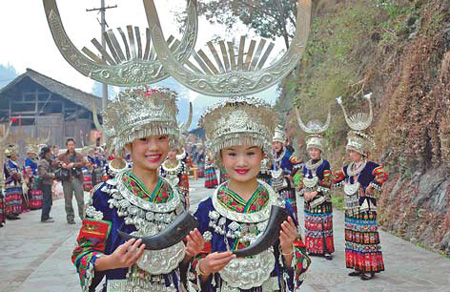Society
Modernity can be two-way street for cultural heritage
By Hu Yongqi (China Daily)
Updated: 2010-11-03 08:17
 |
Large Medium Small |
Learning the language
 |
|
Pan Ying, 46, in Mandong village has been weaving for more than 25 years. The loom she uses is the same her mother used for about five decades. [Hu Yongqi / China Daily] |
And it is not only handicrafts that are at risk. Unique languages used only in remote regions of China could also disappear.
The dialects used in ethnic Miao and Dong villages have no written form and cultural heritage experts say they are racing against time to stop them dying out with older generations.
In the 1950s, almost every Miao could speak the ethnic language. Yet, today it is roughly only 45 percent, Lei Xiuwu, director of the Qiandongnan Institute of Ethnic Studies, said in his speech at the Ninth Senior Anthropology Forum in Kaili on June 22.
All 160 scholars in the audience agreed in a memorandum that a fundamental aspect of safeguarding ethnic cultures is to preserve their languages.
Museum director Cao Chunhan explained that, due to the popularization of compulsory education, children from ethnic groups no longer receive a bilingual education in Mandarin and their local dialects.
Youngsters living with migrant-worker parents in large cities also struggle to learn ethnic languages, usually because there is nowhere to study them.
To encourage a greater use of local dialects, Lei suggests authorities develop ethnic tourism.
 |
|
Young Miao women greet visitors at the entrance of their village with bull horns, which are traditionally used to hold rice wine. [Chen Peiliang / for China Daily] |
Xiao Qianhui agrees. As a visiting professor of tourism with Nankai University in Tianjin, he has been helping Qiandongnan to better cater to visitors for three years.
"The prefecture has a great advantage in its ethnic diversities and unique ecological environment," he told China Daily, "so tourism should be promoted to improve the living standard and preserve the traditional culture."
Qiandongnan is home to about 1.7 million ethnic Miao and 1.3 million ethnic Dong residents, making it an area rich in heritage.
A total of 39 traditions are already recognized as intangible cultural heritage at national level, with another 124 listed by Guizhou province. Experts say that all have the potential to attract tourists, such as the famous Dongzu dage, grand choirs of Dong singers.
"The traditions (already recognized) are only a few outstanding examples of our diverse cultures," said Su Zhourong, the prefecture's director of intangible cultural heritage. "We have to make use of these invaluable resources."
She said her office is now applying to the United Nations to recognize Miao traditional costumes as world cultural heritage.
Official tourism figures show that Qiandongnan received 14 million visitors in 2009, generating more than 10 billion yuan in revenue. The peak time was during the National Day holiday week in October, when residents earned in excess of 4.8 million yuan.